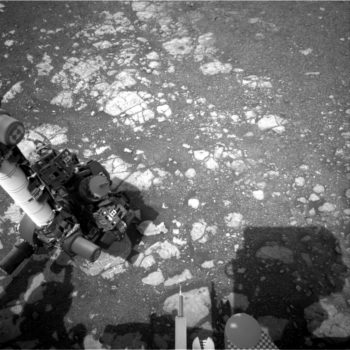
Curiosity Front Hazcam Left A image acquired back on Sol 2199, October 13, 2018.
Credit: NASA/JPL-Caltech
Now in Sol 2205, word about NASA’s balky Curiosity Mars robot is that rover science is back…well, sort of.
Sarah Lamm, a planetary geologist at the Los Alamos National Laboratory in New Mexico reports that the rover team is excited that science operations are starting to resume.
The last images from the Mars machinery were taken on October 13, 2018.
Anomaly work continues
“The real fright was when Curiosity had an anomaly on Sol 2172 which affected its memory,” Lamm says. “Since then, the engineering team has continued to diagnose the anomaly and plan the recovery, including taking the first images with the A-side engineering cameras that haven’t been used since 2013! Thanks to our hard-working engineers, Curiosity is ready for limited science operations while the anomaly work continues.”
Lamm adds that Curiosity has been at the (sadly) unsuccessful “Inverness” drill site since the anomaly. “Curiosity is still exploring the gray Jura member on Vera Rubin Ridge.”
Data collecting
The uplink plan for Sol 2204 called for active and passive use of the robot’s Radiation Assessment Detector (RAD), the Dynamic Albedo of Neutrons (DAN) and the Rover Environmental Monitoring Station (REMS).
RAD detects high-energy radiation on the Martian surface.
“RAD’s data will help shape future human mission to Mars by letting us know how much shielding from radiation future Mars astronauts will need to protect them,” Lamm explains. “REMS is Curiosity’s weather station. REMS can measure pressure, humidity, ultraviolet radiation, and temperature. DAN (Dynamic Albedo of Neutrons) detects neutrons that be used to measure the amount of hydrogen and other elements in the subsurface.”


